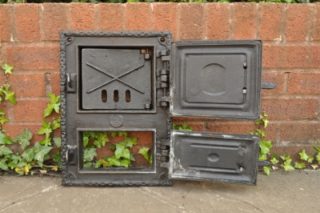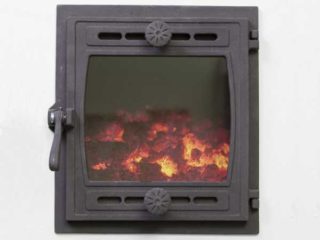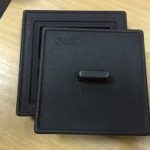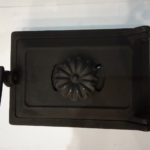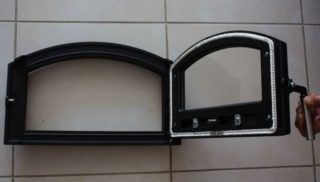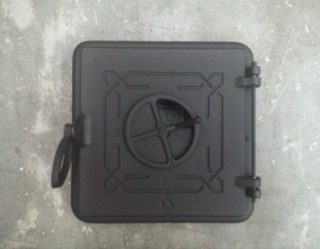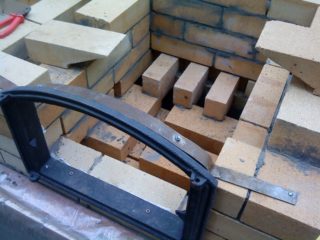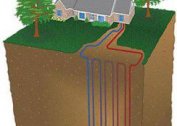Heating a home with stove heating does not lose relevance. The construction of a furnace requires special skills and knowledge. An important part of it are the stove doors. The safety of operation, sustainable combustion of fuel, and attractive appearance depend on their choice. This element has several purposes, some are used for laying firewood, others for cleaning the chimney, the removal of combustion products, air intake.
Varieties of doors according to the manufacturing method
For the manufacture of oven doors, various materials are used: metal, cast iron, glass. Cast iron and metal structures have been used for a long time, heat-resistant glass is a new material.
Glass
Doors for ovens with glass have been used for the past 10 years. Glass sheets are made in several versions:
- Single layer. They have a thickness of 3 mm and are used for burning wood, peat, and plant waste in the furnace.
- Multilayer, 4 mm thick. They are installed during the combustion of coal having a high combustion temperature.
Transparent, frosted or embossed glass is installed in the doors for the stove. Glass doors provide an opportunity to observe the flame. For transparency, it is necessary to wipe the surface with means that remove soot, or buy material with a coating that prevents its formation.
Metal
Ordinary black metal will oxidize when exposed to moisture, this is especially true in the bath room. To prevent rust formation, metal doors are coated with heat resistant paint.
The best, albeit more expensive, option is stainless steel. The product is lightweight, easy to mount in a brick structure. The long term of operation pays off the high price at purchase. Modern design makes this element of the furnace a decoration of the interior of the room.
Cast iron
A cast iron oven door is the best choice. It has the following advantages:
- durability, service life is practically unlimited;
- high heat resistance;
- wear resistance;
- universality of use.
Cast iron products are used in furnaces where coal is burned. High temperature (up to 8000С) arising during combustion does not damage the structure. For a demanding consumer, they develop a complex design of doors for the stove, combine with glass inserts.
When casting iron products for the furnace, complex technologies are used, decorating them with ornaments or decorative details complicates the process, making it expensive. Such models are not intended for mass use, but if you want, you can always find a master for the manufacture.
Door groups during masonry
In the design of the stove there are doors for various purposes. Each element has its own role. The following doors are divided:
- furnace;
- View
- blowing;
- clean.
Furnace
Designed for fueling. The furnace door performs the following functions:
- protection of the environment from fire;
- heat transfer from the material burning in the furnace to the room;
- prevention of sparks;
- provides combustion with oxygen.
The material is chosen based on its practicality or desire to decorate the interior of the room. The latest fashion trend is the oven door with glass.
Blowing
It is installed on the ash chamber, through it the furnace is cleaned of ash, which wakes up in the lower compartment. The blower door provides the process with air.Opening or covering it, regulate the flow and rate of combustion of the fuel.
Blower doors are made of cast iron or steel, less often glass. They can be of a simple design, and can be made of cast iron with relief decoration or ornament. They are performed in the same style with the furnace.
Cleaning
Close the hole in the wall of the chimney and serve to clean it from soot and soot. This is a necessary element in the design of the stove, ensuring its proper operation. Some builders ignore their installation, but an experienced stove-maker can never do without cleaning holes. Their presence simplifies the maintenance of the stove and its smokeless operation.
Vyushechnye
So that hot air after burning fuel does not exit the stove, a valve is installed in the chimney. It is a frame with grooves along which the plate moves, overlapping the flue channel. The valve is located in the brickwork of the pipe.
One type of valve is a view. This is a frame with a hole, sides and two covers, located inside the chimney. This double protection provides a dense overlap to the heat output. A view valve is installed on the channel wall, usually it is made of cast iron.
- Cleaning
- Blowing
- Vyushechnaya
Types depending on the design of the stove
If you need a door for the furnace, you should pay attention to its design. They may be leaky, sealed or leakproof.
Ordinary doors
This is the usual classic model with a rotary handle that secures the door from opening. It is installed in simple brick stoves in old village houses. It is not airtight. Such a design may have a mechanism tightly pressing it to the focus.
Hermetic doors
Stove doors with glass can be airtight. To seal the gap around the perimeter, an insulating cord of heat-resistant material is laid. Tightly closed door contributes to strong combustion, high speed of fuel combustion and rapid heating of the room. Sealed doors prevent the penetration of combustion products into the surrounding room and air pollution.
Primary requirements
The main purpose of the stove door is to ensure the fire safety of the home. It prevents the exit of flame and sparks, the loss of coal outside the hearth, protects the room from smoke, accelerates the process of ignition and combustion of fuel. The door material is selected depending on the heating oil used.
Glass should be at least 4 mm, it can withstand temperatures up to 6000 ° C. It is used for stoves and fireplaces heated with wood. In this case, metal doors are also used. When burning in a furnace of coal, coke or mixed fuel, cast-iron doors must be installed, for them a temperature of up to 8000 ° C is permissible.
How to make a door yourself
First of all, the dimensions of the door are measured - the height and width of the furnace hole in which it will be installed. To do this, use a tape measure and a marker. If there is a desire to make an arched door, determine the height in the center and two side dimensions. It is necessary to carry out a drawing on paper to make it easier to make the product.
First, a metal frame is made from corners according to the size of the furnace opening. The door can be with an insert of refractory glass, and can be closed with a sheet of metal. The glass is attached to the frame with bolts; they are not tightly clamped so as not to impede expansion when heated.
The simplest door is a blank metal. A metal plate is welded to the frame, which tightly closes the hole.
Cast iron doors are difficult to make, so they do not do this at home.
A handle and curtains are welded to the structure, painted with heat-resistant paint. Install the door with bolts or anchors.
Door fastening
Mounting is performed in several ways:
- nichrome wire;
- metal strips (clamps);
- self-tapping screws that are installed in the side rails.
The wire is threaded into the hole, folded in half and twisted. Then it is pulled and inserted into a chip in the edge of a brick (5-10 mm deep). The door is fixed with cement mortar, then some ends of the wire are bred onto the walls of the furnace, while others are placed on three bricks and pressed on top with bricks.
Stainless steel flanging plates can be used. They are attached to the brickwork with self-tapping screws. You can use the shell, which is fixed around the perimeter of the furnace hole. The oven door frame can be attached to the structure when laying the hearth, or you can do this later.
The choice of the oven door is a responsible process, its functionality and the safety of the operation of the stove depend on the correct decision.


